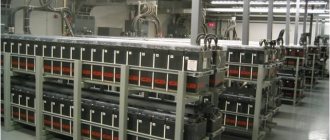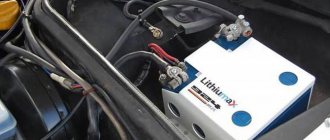In a modern car, the leading role at the moment the engine starts is played by the battery. The operation of the entire on-board electrical system depends on the good condition of the power source and its operational characteristics. It is also necessary that all output parameters, including capacity, voltage and number of amperes, are within normal limits.
What is current strength
Electricity in batteries is generated through chemical reactions during the interaction of an electrolyte (an acidic or alkaline solution of a certain density) and lead plates that act as electrodes. As a result, a current is formed - the ordered movement of charged particles. Current strength is usually called the amount of electricity moving in the cross section of a conductor per unit of time (second).
The classic version, under ideal conditions, assumes that the current strength throughout the entire circuit is constant. Practice proves that the final value is influenced by various external factors:
- ambient temperature;
- possible sources of electromagnetic radiation located nearby;
- complexity of the electrical circuit, etc.
For a car battery, an important parameter is the starting current, which in some sources is also called cold cranking current (Cold Cranking Amps - CCA).
In Russia, state standards have been established for manufacturers of automotive power supplies according to CCA. The lower threshold values of batteries are limited in GOST 53165-2008. According to the current standard, without landing, the battery is required to output below 9 V at the terminals for 30 seconds at an ambient temperature of -180 C.
A parameter such as the battery capacity is related to the amount of electricity. The value is measured in ampere hours. During normal operation, motorists are not recommended to discharge the battery below the minimum limit values. This will negatively affect the further operation of the device.
The capacity value helps to calculate the approximate period for the battery to return its charge. The capacity is directly dependent on the current strength, so during testing the discharge conditions are standardized. For most batteries, the capacity is 60 Ah, respectively, for a twenty-hour discharge the amperage will be 3 A, and for a ten-hour operation - 6 A. For a discharge current of 25 A, the typical battery capacity will be 40 A, providing power to the on-board system for 96 minutes.
Battery types
Before we find out how many amperes are usually in a classic 12-volt car battery, let's look at the types of power sources. There are the most popular battery options, such as acid and alkaline. In the first case, metal plates (electrodes) are immersed in a solution of sulfuric acid, and in the second case, the liquid is an alkaline solution.
For northern regions, it is not recommended to use alkaline power sources, as they do not perform well at low temperatures.
Regardless of how many amperes there really are in an alkaline car battery, they are available in two versions: nickel and lithium. The former may contain cadmium or metal hydroxide in combination. Due to their large dimensions, such devices are more in demand on electric forklifts or trucks, since there is more space for the placement of cells with a lower specific current compared to acid analogues.
Lithium power supplies are cheaper to manufacture, but in practice they are very sensitive to low temperatures. This equipment has proven to be in demand in electric vehicles.
Acid batteries are available in the following types:
- Antimony. Lead plates include more than 5% antimony. Although such a battery is capable of withstanding a significant number of discharges/charges, due to other disadvantages it is not used in modern cars.
- Low antimony. They are manufactured using a similar technology as antimony batteries, but with a lower percentage of antimony. They have better practical characteristics.
- Calcium. The plates in them are made with the addition of calcium compounds (without antimony). In some models, the electrodes include silver alloys. Power supplies are quite sensitive to frequent deep discharges, but have stable operating parameters.
- Gel or AGM batteries. This technology assumes that the electrolyte is in a jelly-like (gel) state. Such models are significantly higher in price than liquid analogues - 2–3 times. Their advantages are high resistance to frequent deep discharges and good output parameters, but their disadvantages are the need for a high-quality charger with reduced current parameters and stable consumers.
Number of amperes in a charged car battery
The battery capacity is indicated on the battery case or in the operating instructions (passport). Let's look at how to independently check the indicated amps on your battery. Capacity is important for a motorist, since it can be used to find out how much charge the battery will have time to deliver over a certain period of time. The parameter is measured in ampere hours.
Monitoring is carried out under load and without it. The readings are given by a multimeter, and a regular lamp serves as the load. A charged battery should show good performance when the light stays on for a long time, but if it quickly starts to go out, then the battery is faulty. In such testing, we recommend taking a 35–40 W lamp and holding it for about 2 minutes.
A car battery that was charged before measurements and after loading produced a voltage above 12.4 V can be considered serviceable. If the values are reduced, you should consider purchasing a new power source.
Most power sources located in the engine compartment of passenger cars have a capacity of 55–65 Ah. This is quite enough to start the engine in any weather. However, it is worth considering that a car parked in a garage or parking lot gradually consumes current for small needs, for example, a clock on the dashboard, alarm system, central locking, injection controller, etc. If the total volume of consumers does not exceed 50–70 mA, then this will not prove critical. Otherwise, you need to think about reducing current consumption or buying a more powerful battery that can produce more energy.
Battery capacity.
Battery capacity
- this is the amount of electrical energy that a fully charged battery can deliver at a certain discharge mode and temperature from the initial to the final voltage. The SI unit for electrical charge is the coulomb (1C), but in practice capacity is usually expressed in ampere-hours (Ah).
Capacity is measured in ampere hours and determined by the formula:
C=Ip *tp, where C is capacity, Ah;
I p – discharge current strength, A;
tp – discharge time, H.
Nominal capacity
- the capacity that a new fully charged battery should give under normal discharge conditions specified in the standard for this battery. In this case, the voltage should not fall below a certain value.
Since the capacity depends on the discharge current and the final discharge voltage, the battery designation indicates the capacity corresponding to a specific discharge mode. For starter batteries, the nominal capacity is taken at 20-hour, stationary at 10-hour, traction at 5-hour discharge modes.
An example of assessing the battery capacity using a 20-hour discharge mode with a current of 0.05 C20 (current equal to 5% of the nominal capacity). If the battery capacity is 55Ah, then discharging it with a current of 2.75A, it will be completely discharged in 20 hours. Similarly, for batteries with a capacity of 60Ah, a full 20-hour discharge will occur at a slightly higher discharge current - 3A.
Capacity return is the ratio of the amount of electricity received from the battery during discharge to the amount of electricity required to charge the battery to its original state under certain conditions.
It depends on the completeness of the charge. Part of the charge is lost to gas formation, which reduces the recoil coefficient.
Residual capacity
– a value corresponding to the amount of electricity that a partially discharged battery can give out when the discharge mode is set to the final voltage.
Battery reserve capacity
— the time during which the battery can ensure the operation of consumers in emergency mode. The value of the reserve capacity, expressed in minutes, has recently been increasingly indicated by manufacturers of starter batteries after the value of the cold start current.
Charging capacity
- the amount of electricity supplied to the battery during charging. The charging capacity of the battery is always greater than the discharge capacity due to energy losses due to side reactions and processes.
At a constant charging current l, the charging capacity C = I * t, where t is the charging time.
The capacity is measured until the voltage of at least one battery cell drops to a value regulated for a specific discharge mode.
Over the course of its service life, the battery capacity changes. At the beginning of the service life, it increases as the active mass of the plates develops. During operation, the capacity remains stable for some time, and then begins to gradually decrease due to the aging of the active mass of the plates.
The capacity of the battery depends on the amount of active material and the design of the electrodes, the amount and concentration of the electrolyte, the magnitude of the discharge current, the temperature of the electrolyte, the degree of wear of the battery, the presence of foreign impurities in the electrolyte and other factors.
As the discharge current increases, the battery capacity decreases. Batteries under forced discharge modes yield less capacity than when discharged under longer modes (low current). Therefore, batteries may have symbols for 3, 5, 6, 10, 20 and 100 hours of discharge. In this case, the capacities of the same battery will be completely different. The smallest will be with a 3-hour discharge, the largest with a 100-hour discharge.
As the temperature of the electrolyte increases, the capacity of the electrolyte increases, but at excessively high temperatures, their service life decreases. This happens because, with increasing temperature, the electrolyte penetrates more easily into the pores of the active mass, as its viscosity decreases and the internal resistance increases. Therefore, more active mass takes part in the discharge reaction than when charging at a lower temperature.
At low temperatures, the capacity and useful action of the battery quickly decreases.
If you increase the concentration ( electrolyte density ), the capacity will also increase, but the battery will quickly fail due to loosening of the active mass of the battery.
How to charge a car battery
There are several ways to charge the battery in a car. In the first case, you can make do with the built-in equipment in the car. It is enough to start the engine without removing the battery and drive it at high speeds for about 10–15 minutes. It is necessary to carry out such an operation not in garages or closed boxes, but in the open air, so as not to be poisoned by toxic exhausts.
We recommend that the event be carried out during the daytime to avoid the use of electric lighting devices. You also need to turn off the audio system, heated windows, mirrors, steering wheel, seats and other electricity consumers.
In the second case, you will need an external charger. It is preferable to remove the battery from the car and charge the battery by placing it on a flat horizontal surface. Next we carry out the following actions:
- in serviced batteries, we slightly unscrew the plugs to ensure gas escape, and in unserviced batteries, we check the gas outlet holes;
- connect the positive contact of the charger to the positive terminal, and the negative contact to the negative terminal;
- turn on the device and set the current on it to 1/10 of the capacity, for example, a 55 Ah power source requires a current of 5.5 A, and a 60 Ah unit requires a current of 6 A;
- we leave the connected battery for about 9 hours, monitoring the degree of charge, since the exact time depends on the performance characteristics of the battery and the output parameters of the charger;
- After turning off, you need to let the battery stand for 15–20 minutes so that all the gas comes out, and only then tighten the plugs until they stop.
A fully charged battery gives, after measurements with a multimeter at the terminals, 12.6–12.7 V without a connected load. For a regularly used battery, normal values are in the range of 12.3–12.2 V. You should not allow acidic devices to significantly discharge, as this will negatively affect their service life.
Companies sometimes don't have the option to write "Ah" instead of "mAh"
Manufacturers have adopted specifications for designating battery capacity. General rules were built based on the traditional calculation of battery capacity in mAh for mobile devices and most often in Wh for laptops (we talked about why there are such differences here).
Deviations from generally accepted specifications may result in losses.
For a complex technical product, any deviation from the rules, standards and restrictions can result in problems in various markets, depending on the laws of specific countries.
The tradition of denoting mobile batteries in mAh dates back to the days of batteries for cameras, common types AA and AAA, special elements for toys, radios, and so on. The specification was formed over the years and remained virtually unchanged.










